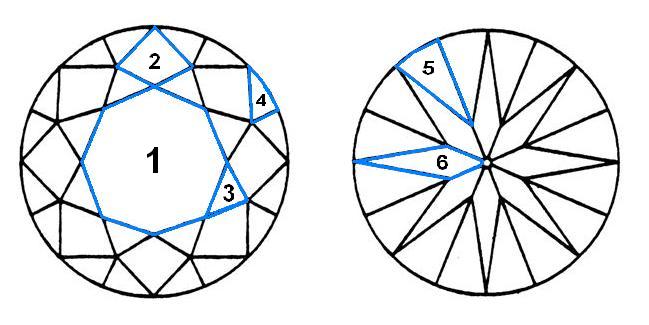Diamond Facets: Understanding the Cut & Light Performance
A facet is a flat, polished surface on a diamond that interacts with light to create brilliance, fire, and scintillation. The number, arrangement, and angles of these facets determine how well a diamond reflects and refracts light.
Types of Facets in a Diamond
A brilliant-cut diamond (such as a Round Brilliant) typically has 57 or 58 facets, depending on whether the culet is faceted. These facets are grouped into different sections:
Table Facet – The largest and central facet on the crown, responsible for most of the light entering the diamond.
Crown Facets – The upper portion of the diamond, including:
Star Facets (8) – Surround the table and direct light into the diamond.
Bezel Facets (8) – Kite-shaped facets between the star and upper girdle facets.
Upper Girdle Facets (16) – Connect the bezel facets to the girdle.
Girdle Facets – The outer edge, which may be bruted, polished, or faceted.
Pavilion Facets – The lower half of the diamond, responsible for light reflection, including:
Lower Girdle Facets (16) – Extend from the girdle down to the pavilion main facets.
Pavilion Main Facets (8) – Larger facets that control the return of light.
Culet Facet (Optional) – A tiny facet at the very bottom of the diamond (if present).
Facet Count in Different Diamond Cuts
Diamond Cut Number of Facets Key Features
Round Brilliant 57 or 58 Maximized brilliance & fire.
Princess Cut 58–76 Sharp corners, modern appeal.
Cushion Cut 58–64 Soft, rounded shape with vintage charm.
Emerald Cut 50–58 Step-cut, mirrors effect, less brilliance.
Oval Cut 57–58 Elongated brilliance, hides inclusions well.
Marquise Cut 58 Elegant, boat-shaped cut.
Pear Cut 58 Teardrop shape with brilliant facets.
Radiant Cut 70 Hybrid of step and brilliant cut.
Asscher Cut 50–58 Square step-cut with deep clarity.
Heart Cut 56–58 Romantic shape, requires symmetry.
Why Are Facets Important?
Brilliance – Facets control how light enters and exits the diamond, creating sparkle.
Fire – Well-angled facets disperse light into a spectrum of colors.
Scintillation – Facets create a contrast of light and dark patterns, enhancing visual appeal.
Cut Quality – The precision of facet arrangement impacts a diamond’s GIA Cut Grade (Excellent to Poor).
Faceted Girdle vs. Polished Girdle vs. Bruted Girdle
Faceted Girdle – Small, polished facets along the girdle to improve light performance.
Polished Girdle – Smooth and shiny, common in step-cut diamonds like Emerald and Asscher.
Bruted Girdle – Frosty or rough, found in older or unpolished diamonds.
1 Table

